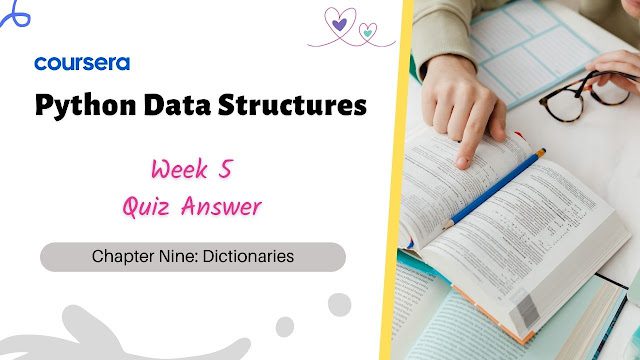Python Data Structures Week 5 Quiz Answers
Hello Friends in this article i am gone to share Coursera Course: Python Data Structures Week 5 Quiz Answers with you..
Python Data Structures
Go to this Course: Python Data Structures
Also visit this link: Python Data Structures Week 4 Quiz Answers
Python Data Structures Week 5 Quiz Answers
Chapter Nine: Dictionaries
Question 1) How are Python dictionaries different from Python lists?
- Python lists maintain order and dictionaries do not maintain order
- Python lists can store strings and dictionaries can only store words
- Python dictionaries are a collection and lists are not a collection
- Python lists store multiple values and dictionaries store a single value
Question 2) What is a term commonly used to describe the Python dictionary feature in other programming languages?
- Sequences
- Closures
- Lambdas
- Associative arrays
Question 3) What would the following Python code print out?
stuff = dict() print(stuff['candy'])
- -1
- 0
- candy
- The program would fail with a traceback
Question 4) What would the following Python code print out?
stuff = dict() print(stuff.get('candy',-1))
- The program would fail with a traceback
- 0
- -1
- ‘candy’
Question 5) When you add items to a dictionary they remain in the order in which you added them.
- True
- False
Question 6) What is a common use of Python dictionaries in a program?
- Sorting a list of names into alphabetical order
- Computing an average of a set of numbers
- Splitting a line of input into words using a space as a delimiter
- Building a histogram counting the occurrences of various strings in a file
Question 7) Which of the following lines of Python is equivalent to the following sequence of statements assuming that counts is a dictionary?
if key in counts: counts[key] = counts[key] + 1 else: counts[key] = 1
- counts[key] = (key in counts) + 1
- counts[key] = (counts[key] * 1) + 1
- counts[key] = key + 1
- counts[key] = counts.get(key,0) + 1
- counts[key] = counts.get(key,-1) + 1
Question 8) In the following Python, what does the for loop iterate through?
x = dict() ... for y in x :
- It loops through the values in the dictionary
- It loops through all of the dictionaries in the program
- It loops through the keys in the dictionary
- It loops through the integers in the range from zero through the length of the dictionary
Question 9) Which method in a dictionary object gives you a list of the values in the dictionary?
- all()
- keys()
- each()
- values()
- items()
Question 10) What is the purpose of the second parameter of the get() method for Python dictionaries?
- The value to retrieve
- The key to retrieve
- To provide a default value if the key is not found
- An alternate key to use if the first key cannot be found

